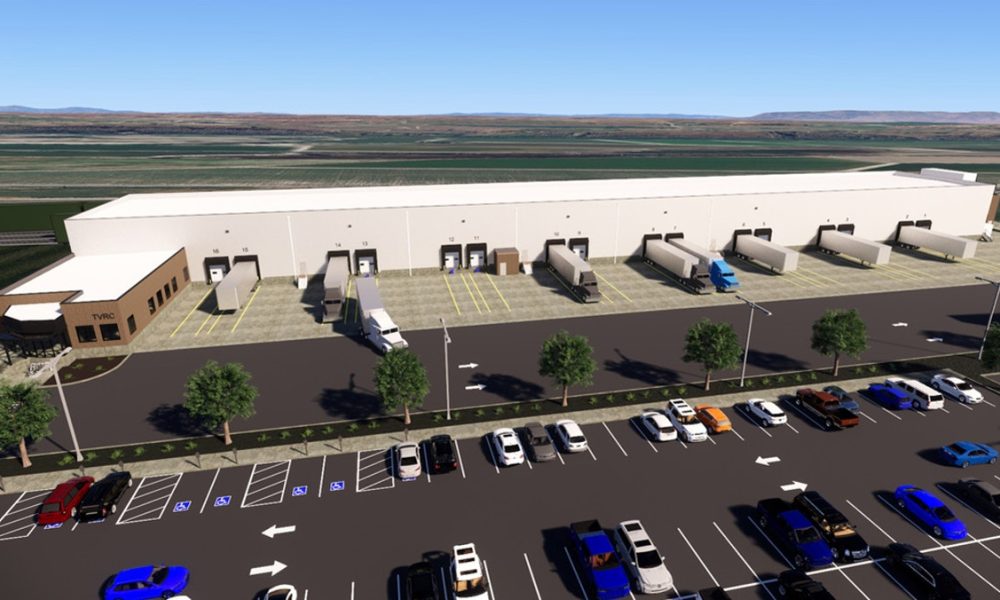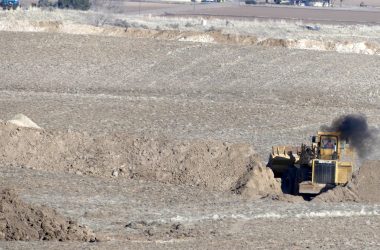 This artist depiction of the $26 million rail reload facility north of Nyssa shows trucks off-loading commodities. A recent report shows the facility will be smaller and employ fewer people than estimated. (Graphic courtesy of Malheur County Economic Development)
This artist depiction of the $26 million rail reload facility north of Nyssa shows trucks off-loading commodities. A recent report shows the facility will be smaller and employ fewer people than estimated. (Graphic courtesy of Malheur County Economic Development)
NYSSA – The rail reload facility planned north of Nyssa will employ fewer people and be a smaller facility then originally projected.
That’s according to a plan delivered recently to state transportation officials by Greg Smith, Malheur County economic development director.
The report consisted of an economic feasibility study, cost estimates and a site plan and the state now has until the first of the year to decide the feasibility of the project. That’s key to releasing $24 million to build the depot.
For more than a year the facility has been viewed as a major economic game changer where farm products would be trucked into the rail reload center and loaded on to trains for shipment across the country.
Early plans showed the facility could employ up to 125 people.
That isn’t the case now, according to the market feasibility study. Instead, the reload center would employ seven full time and about 13 to 19 seasonal staff.
Smith said the project would be built in phases and that the smaller work force is needed for the first phase.
Once all phases are finished and fully “built-out” the number of jobs will be closer to 125 to 150, Smith said.
“The first phase warrants fewer employees initially,” said Smith.
When those jobs would be available is also hard to predict, said Smith, but could be over the next seven to 10 years “because there is so much market variability.”
The market feasibility study projects construction of the facility will produce 148 jobs. According to the study, once it is operational the facility will employ an average of 16 people.
At the facility, area shippers will unload their products into the warehouse. The products will then be loaded onto refrigerated rail cars.
The report said the facility will be especially beneficial for onion producers who will save up to $1.8 million in shipping costs.
Early projections called for a 70,000-square-foot warehouse with railroad tracks on each side and loading docks.
The market feasibility study, however, shows the warehouse will be 60,000 square feet.
The report also sketches a construction timeline that begins in November 2019. That date, though, isn’t correct said Smith.
“I don’t know why it did that. I would fully anticipate by spring of 2019 we will begin moving dirt,” said Smith.
Smith said the alterations to the plan are because of a lack of funds.
“The reality is the demand in the valley is there and $26 million is a lot of money but it only builds so much infrastructure. I have to figure out, within $26 million, how to buy land, get water and sewer out there and how to build rail,” said Smith.
A new access road to handle an upsurge in truck traffic off Oregon Highway 201 has been shelved for now to help shave costs.
That means truck traffic – up to 170 a day – would be funneled through Nyssa.
“We are trying to work through that issue, work closely with the city of Nyssa. Our priority is to keep trucks out of the city and residential areas. While we’ve identified options, in the end it will be up to the city, the development corporation and ODOT to help with the best route for trucks,” said Smith.
In the report, costs for the rail infrastructure were “excluded since it is not produced or acquired within the study area.” Smith said that isn’t correct either.
“The $26 million includes the rail,” said Smith. The report also assessed whether the site north of Nyssa was suitable.
“The site is believed to be free of contamination concerns, has no cultural resource concerns, has some wetlands that can be mostly avoided and mitigated, where required, and has soils that will accommodate the proposed improvements,” the report said.
Smith said there is “tremendous demand” for the facility.
“But we don’t have enough money to accommodate all that demand,” said Smith.
How much demand and from whom is also still unknown. That’s because, Smith said, of confidentially agreements with firms that have expressed interest in using the facility.
“Two of them are local onion shippers that want to expand their existing operations in the county, expand closer to the rail line,” said Smith.
Smith said a hay compression firm in Harney County and a local truck repair company have also expressed interests in using the reload center.
The report said that the unidentified hay producer was seeking financing to erect a hay press in Nyssa at the rail terminal.
The report said Harney County hay farmers now have to truck their hay to Washington, California and Portland.
“Trucking hay instead to Nyssa and loading it into intermodal containers that could be railed to ports would potentially reduce Harney County’s hay growers’ shipping costs by half,” the report said.
The crucial player in the facility is Union Pacific. The rail firm owns the tracks that will run by the facility and its cooperation will be essential to success. But a letter of support from the railroad company made it clear it’s not ready to commit.
“Effectively what Union Pacific is saying is we will help you design this, but the level of service and the price depends upon local industry and their desire to use the facility,” said Smith.
The market, said Smith, will dictate Union Pacific’s level of support.
“UP is saying in terms of how it operates and when we stop and at what price will be based on a free market supply and demand,” said Smith.
Smith used the operations of a restaurant as an example of Union Pacific’s role in the reload center.
“Like a restaurant, it will stay open 24-7 but if customers don’t use it they will shut down early,” said Smith.
Some shippers, primarily of onions, expressed “skepticism” about Union Pacific’s level of commitment in the market feasibility study.
“Most shippers were looking for guaranteed or committed levels of service, including rail car allocation. Some expressed skepticism that the facility could get this level of consistent service because Union Pacific owns the competing facility in Wallula, Washington. Shippers indicated adequate rail car availability as a necessity for the proposed facility,” the report said.
Smith said the service issue will be one the reload facility manager and local shippers will need to work out.
“They will have to negotiate with Union Pacific for the best possible rate and that is based on supply and demand. One thing I can’t control is a shipper who is satisfied with their current service and may not use the facility,” said Smith.
The economic feasibility study estimated the facility would eventually generate more than $720,000 a year in profits. Smith said that profit would be “a few years down the line.” The use of that money would be up to Malheur County Development Corp., the county-created business running the terminal project.
“It isn’t a conversation we’ve had yet. I would anticipate initial dollars for the first number of years are going to be used to reinvest in the facility and the infrastructure. We don’t want to take away from the investment right off,” said Smith.
Smith also said the development corporation plans to hire Gary Neal, the current manager of the Port of Morrow, as a consultant when he retires in December.
Neal has led the port to dramatic economic expansion in Boardman.
Smith said, though, that Neal has not been officially offered a job. If he is hired, Smith said, Neal would probably earn around $3,000 a month during the project’s construction.
“It’s no different than if we hired a surveyor or an architect or a land use expert or a plumber. The amount of money we end up paying Gary will be fully realized through efficiencies and savings,” Smith said.
The money to pay for Neal will come from the project budget said Smith.
Reporter Pat Caldwell: [email protected] or 541-473-3377.




